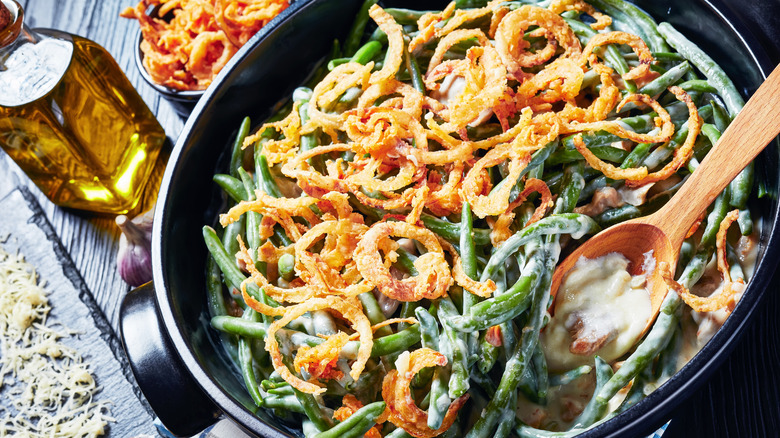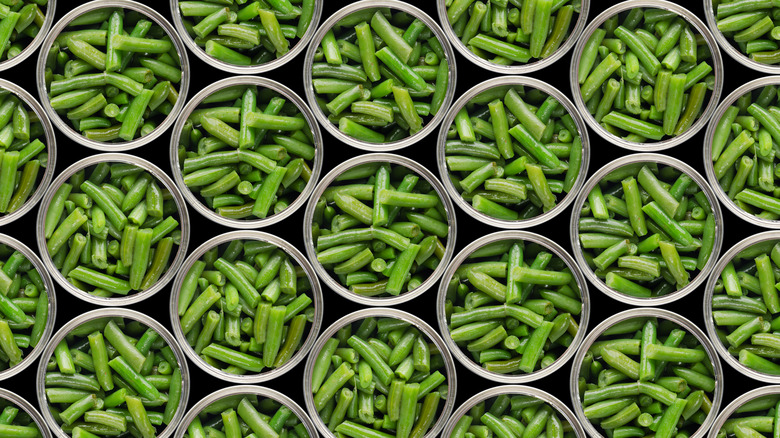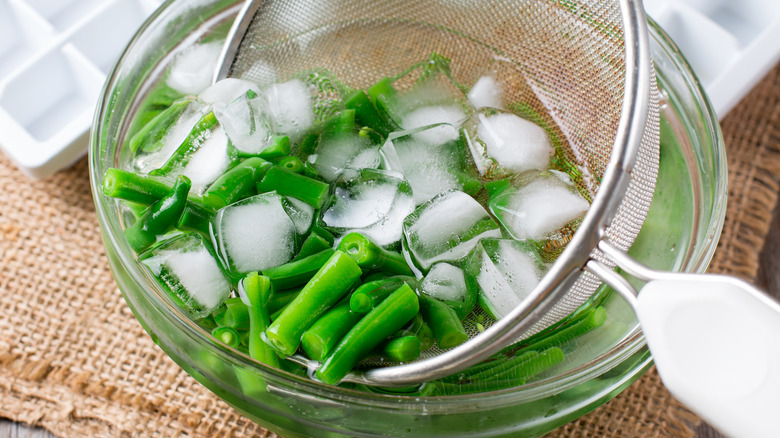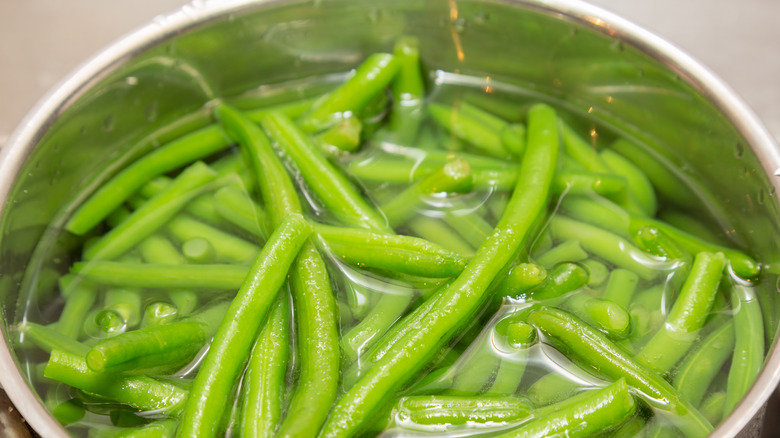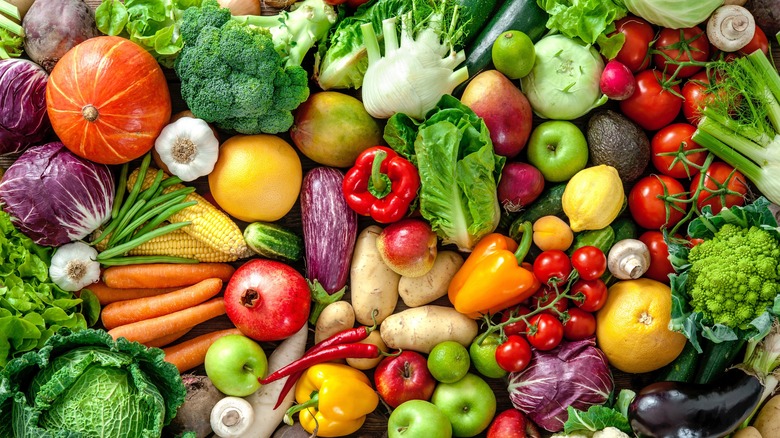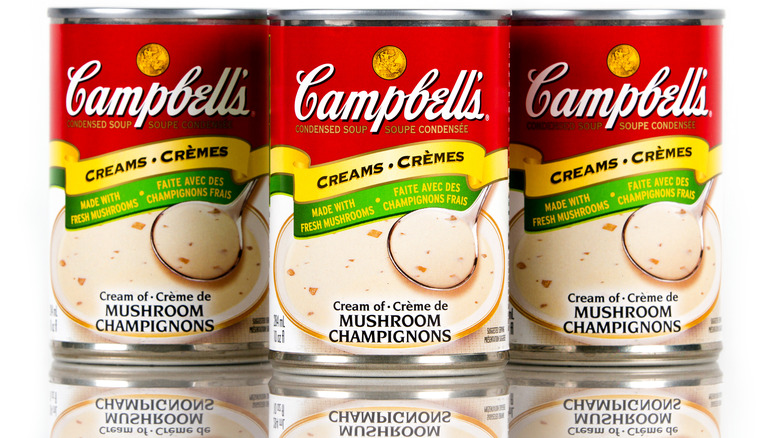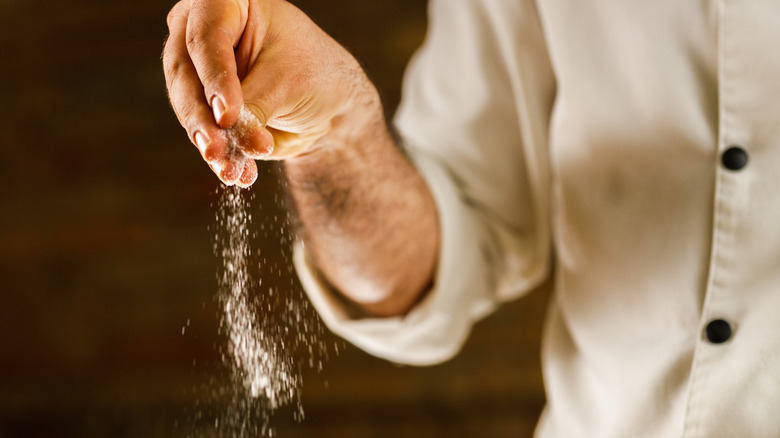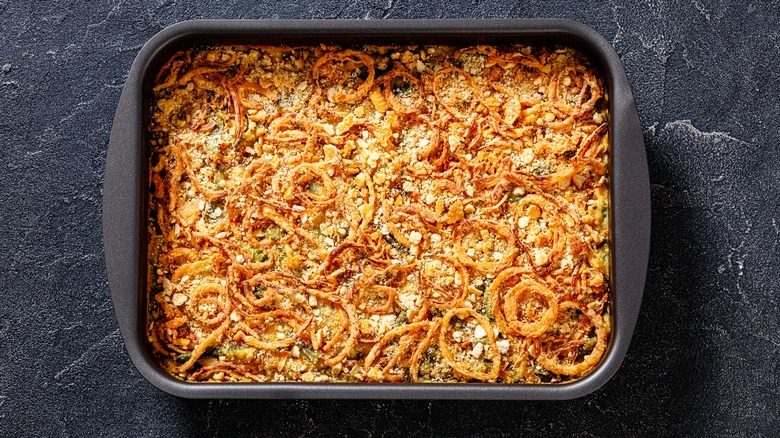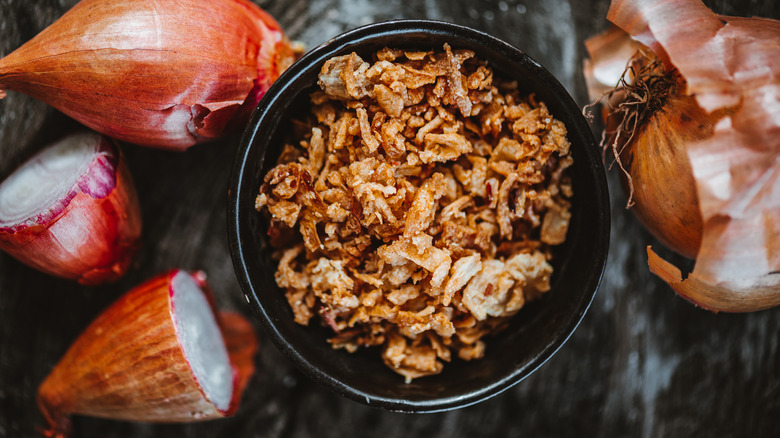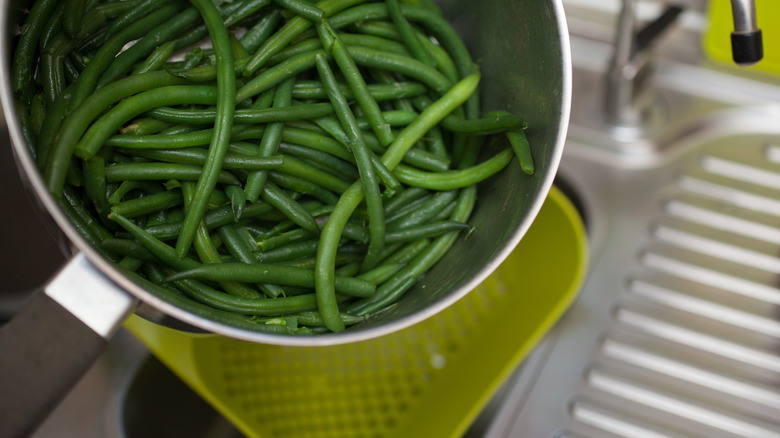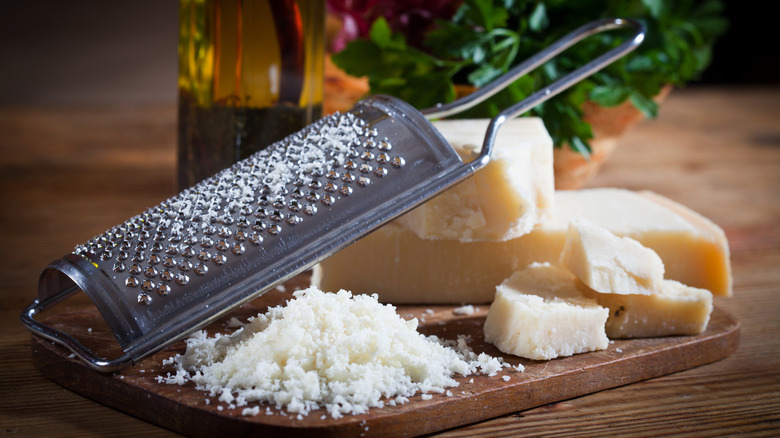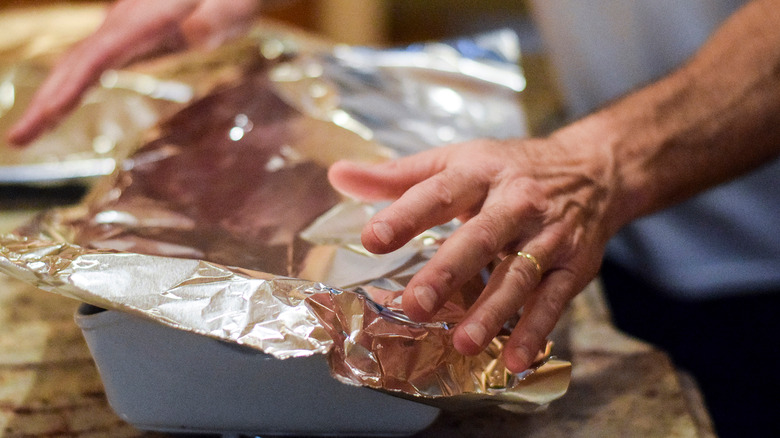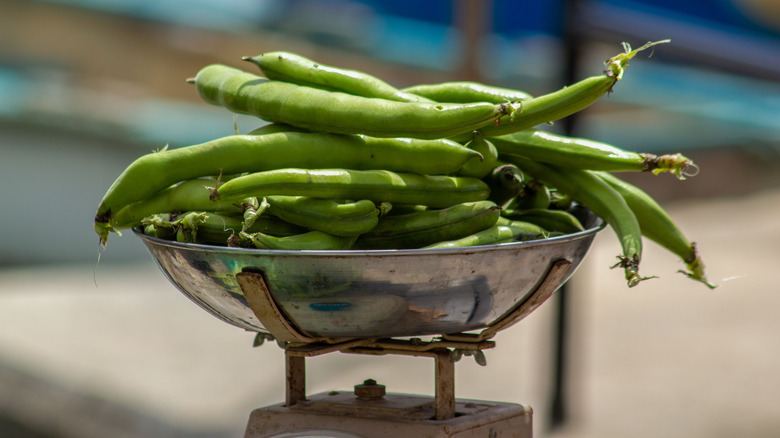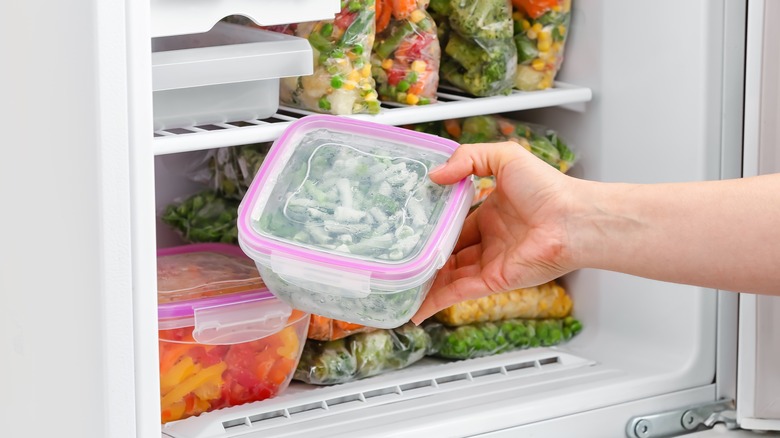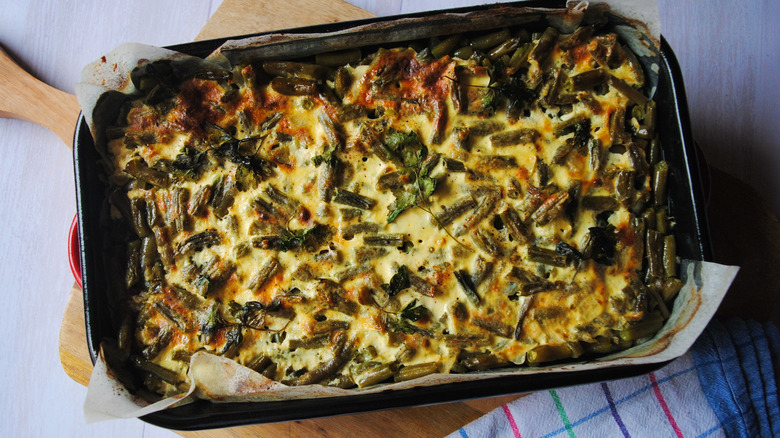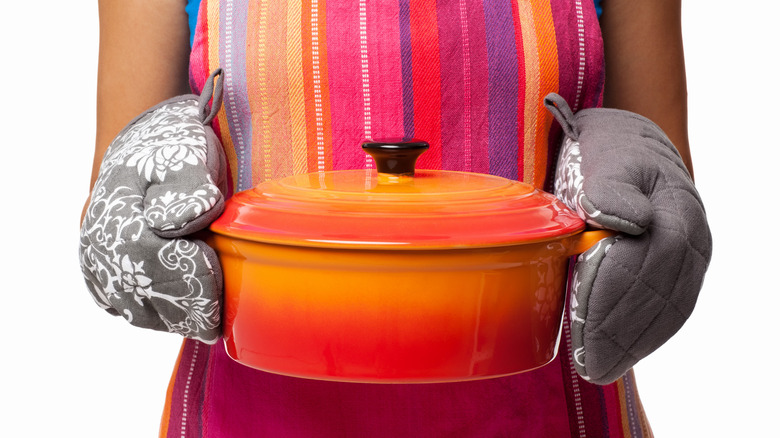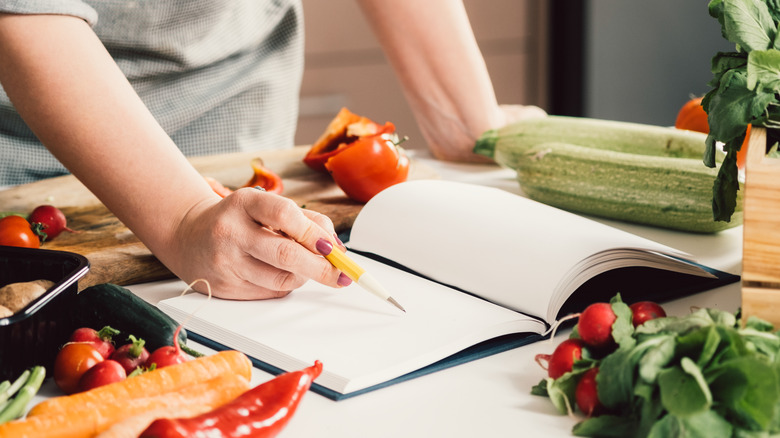Mistakes Everyone Makes When Cooking Green Bean Casserole
Green bean casserole is a classic dish that's earned its place at tables across America, especially as a staple side at holiday dinners. A straightforward yet iconic combination of tender and crunchy green beans, rich cream of mushroom soup, and crispy fried onions, the traditional dish is beloved for both its ease of preparation and its comforting flavors.
However, despite green bean casserole's roaring popularity, simple recipe, and affordable ingredients, there are plenty of mistakes that people make while preparing it. The impact of these blunders can vary from resulting in a dish that doesn't quite live up to its full potential to turning the casserole into a soggy, flavorless stew. Fortunately, all of these potential mistakes are easy to avoid or fix once you know what to be aware of — we've covered the most common ones below.
Using canned green beans
Whether you use canned or fresh green beans in your casserole is ultimately down to personal preference, as both options have their own benefits and drawbacks. There's no denying the convenience of canned beans, but there is a trade-off.
From a nutritional perspective, there isn't a vast difference between canned and fresh green beans, but the latter is still the healthier choice, especially if you're watching sodium intake and want the extra vitamins in your diet (via Prevention). As canned beans are pre-cooked, it can make it easier to overcook them in your casserole which may impact the flavor, and they're more likely to lose their fresh coloring and turn a less appealing shade of gray-green. Lastly, there's no beating the texture of fresh green beans which are more likely to retain their crispiness, contrasting nicely against the soft mushroom soup (in the casserole) and enhancing the overall dining experience.
Not blanching the green beans
Blanching is a cooking process that involves submerging vegetables in boiling water for a few minutes before transferring them to an ice bath. This technique effectively initiates cooking and then immediately halts it.
The reason for this is to rapidly deactivate the enzymes that activate when the cooking process starts, which can have a few different effects on the vegetables being blanched. In the case of fresh green beans, blanching not only helps to slightly soften them before you add to the casserole mix, but it also provides a huge boost to their coloration, resulting in a vibrant green hue.
As soon as the beans are cooled, you want to remove them from the ice bath to prevent them from taking on too much water and becoming soggy. It may take a few attempts to perfect the process, but the results are worth it.
Overcooking the green beans
One of the best things about green bean casserole is the interplay of textures between the creamy mushroom soup, the crunchy green beans, and the crispy fried onions on top. Overcooking the beans won't just drain them of their appealing color, but it will also make them too soft and mushy, resulting in a less appetizing casserole.
The first thing to bear in mind is that canned green beans are pre-cooked, so you don't need to cook them again before adding them to your casserole mix. If you're using fresh beans, the important thing is not to overcook them during the first stage of the blanching process in the boiling water. It's also possible to steam or roast fresh beans before adding them to your casserole, but you'll want to cook them for less time than usual to account for the time they'll spend in the oven.
Skipping fresh ingredients
Although seasonings like garlic and onion powder are an excellent way to increase the flavor of a green bean casserole, there truly is no substitute for fresh ingredients. Using fresh ingredients involves a little more prep time, but your taste buds will thank you.
One of the easiest ways to use fresh ingredients to boost your casserole is by sautéing a chopped onion in butter until it's caramelized and tender, then adding sliced mushrooms to the pan until they're soft before throwing in a healthy amount of fresh, diced garlic. Combining these with your casserole mix will amplify the existing ingredients while adding a richness and depth of flavor that processed alternatives just can't match. If you've got some extra time and want to go a step further, ditch the canned mushroom soup and have a go at making your own from scratch using fresh ingredients.
Using too much soup
Cream of mushroom soup is one of the core ingredients in a green bean casserole. Aside from its hearty mushroom flavor, the soup plays an important role in providing the dish's signature creamy sauce texture while introducing a robust umami character.
However, it's possible to overestimate the amount of soup you need and ruin your casserole if you're not careful. Depending on the soup you use, overdoing it might result in a casserole that's too creamy, throwing off the balance of textures, and where the rest of the ingredients' flavors are overpowered by the mushroom. If you feel you've added enough soup but your casserole seems too watery, pouring in more soup won't fix the issue. Instead, mix a little cornflour with some water, then stir it into your mixture before baking. You can always add more after baking if your casserole is still too runny.
Not adding enough seasoning
Most dishes are enhanced with seasoning, and it doesn't take much to elevate the quality of a green bean casserole. At minimum, you should add liberal pinches of salt and pepper to your dish to bring out the best flavor.
There are plenty of other simple seasonings you can experiment with that complement the taste profile of green bean casserole. Onion and garlic powder are particularly impactful additions that will improve flavor, and if you're feeling slightly adventurous, herbs like thyme or rosemary are a great choice. You can also add creole seasoning for a subtle yet spicy kick. When seasoning, however, bear in mind that canned beans will already taste saltier than fresh ones, and some varieties of mushroom soup may already be seasoned, so check the ingredients beforehand to make sure you don't overdo it.
Neglecting to add texture
After taste, texture is arguably one of the most important factors when it comes to how enjoyable we find food. We've already touched on how the textures of a green bean casserole's main ingredients are part of what makes it such an iconic dish, but there's no reason we can't take things a step further for an even tastier meal.
You shouldn't need to make your casserole creamier unless you're thickening a watery sauce, but you can definitely incorporate more crunchy elements to improve texture. If you don't want to change the flavor of your dish, breadcrumbs are an excellent topping to add before baking, or panko breadcrumbs for an even crispier bite. Also, a sprinkling of pine nuts or toasted almonds will add a delectable crunch while introducing a subtle nutty flavor that works wonderfully with the rest of the casserole ingredients.
Using stale or low-quality fried onions
After the green beans and mushroom soup, crispy fried onions are the final ingredient required for your dish to be considered a true green bean casserole. Not only are they sprinkled on top of the casserole before baking, but many home cooks stir them through their mushroom and green bean mixture as well.
For the best results, you can make your own fried onions by soaking extra thin onion slices in buttermilk, dredging them in a seasoned batter of flour, and frying them until they're super crispy. There's nothing wrong with using store-bought fried onions but if you do, try not to skimp on the quality. Whichever option you pick, make sure you avoid using stale onions or the texture and flavor of your casserole will suffer. While homemade onions need to be consumed within a few days, most store-bought varieties have much longer shelf lives.
Not draining canned ingredients
Although using completely fresh ingredients is the tastiest and healthiest way to go, there's nothing inherently wrong with using canned ones, and you can still make a superb green bean casserole with them. However, if you do use canned vegetables, it's crucial to drain them completely before adding them to your dish.
If you don't fully drain your vegetables, the extra water will dilute your mixture and might result in a thinner, less appealing casserole. While it's possible to thicken it up afterward, you want to avoid this if possible. Also, the water inside canned vegetables is often salty to help preserve the can's contents, so may throw off the balance of flavors. To ensure your vegetables are fully drained, empty the can into a sink or colander over the sink. Give them a good shake, transfer them to a bowl, and strain one more time.
Skipping the cheese
While not every casserole benefits from introducing cheese to the recipe, green bean casserole is a dish that can be improved immensely by it. Delicious cheesy flavor aside, adding a handful of grated cheese to your mixture can thicken it up and give it a wonderful gooey consistency that contrasts with the crunchy green beans and crispy fried onion.
Although not all types of cheese are ideal, there are plenty that will do the trick. A medium-mature cheddar is a simple yet effective choice, while a sprinkling of parmesan on the top of your casserole will add a tangy bite to it. Nutty cheeses like Comté or Gouda also work well. If you're a fan of bold and intense flavors, try adding a little blue cheese like Stilton or Gorgonzola to your casserole mix — both pair nicely with the creamy mushroom sauce.
Not preheating the oven
One of the most common mistakes people make when using their oven for any type of cooking is forgetting to preheat it. While some believe this only really applies to baked goods, it's a good habit to get into regardless of what you're cooking.
First, a preheated oven means your dish will become hotter more quickly, therefore spending less time within the "danger zone," the temperature range bacteria are able to multiply. From a quality perspective, an oven that hasn't been preheated might make your casserole cook unevenly, leaving some parts of it under or overcooked. If you're following someone else's recipe, you're also more likely to undercook your dish if the instructions assume your oven is already at the correct temperature when you start your timer. If you forgot to preheat, remember that a late meal is still better than a bad one.
Not covering the casserole while baking
For some casseroles, it's best to cover them with aluminum foil while they're in the oven, others are better left uncovered while baking. In the case of a green bean casserole, the answer isn't quite as straightforward.
Covering a casserole with foil will contain the heat and help it cook more evenly. However, it will also shield the top from external heat while trapping moisture inside. For a dish like green bean casserole, excess moisture is likely to make your crispy ingredients too soggy, resulting in a mushy mess. Having said that, you may still want to keep your foil to hand. If your casserole has a little while before it's done but you notice the top starting to brown too quickly, a loose covering will protect it while still allowing some of the steam to escape to prevent sogginess.
Overlooking the ratio of ingredients
A common misconception about green bean casserole is that because of its minimalist ingredients list, we don't have to pay too much attention to the ratios we use in our mixture. There's certainly some wiggle room, and it's possible to adjust the ratios to your personal preferences, but balance is always important.
Too much mushroom soup will effectively turn your dish into "mushroom soup with green beans" rather than a casserole, and the extra liquid might make the beans and onions too soft. At the same time, adding too many beans defeats the point of making a casserole in the first place. Don't be afraid to experiment with the ratios of your recipe if you're adjusting to specific tastes, just remember that there can always be too much of a good thing. You might even be better off introducing new ingredients to transform the casserole instead.
Neglecting to thaw frozen green beans
Not everyone opts for canned or fresh beans when making a green bean casserole. Frozen beans are also a perfectly viable option; however, it's best practice to completely thaw them first.
Some recipes claim thawing the green beans is unnecessary, and while adding them straight from frozen won't make your casserole inedible, it still leaves more room for error. Frozen beans will release more moisture during cooking which could make your casserole too thin and watery, and having extra cold spots throughout the dish might cause it to cook unevenly. Thawing the beans is simple — just leave them in the fridge overnight and pat them dry before adding them to your casserole mix. If you don't have time to thaw the beans, you may need to bake your casserole for longer, keeping a close eye on it to make sure the top doesn't burn.
Not letting the casserole rest
Most people know that some dishes should be allowed to rest before we eat them, steak in particular. Casseroles are often overlooked; however, they also benefit just as much from sitting a while before serving.
Letting your green bean casserole rest after baking allows time for the flavors to meld together. The ingredients will also settle into place as the casserole cools and its consistency changes. Allowing the dish to cool a little also makes serving easier, and there's a lower risk of someone scalding their mouth by tucking in too early. If you're concerned about your casserole cooling too much, covering the top with aluminum foil will help keep the heat in while the flavors have time to evolve and develop. Five to 10 minutes should be sufficient but this is still a guideline that you may want to experiment with.
Using the wrong dish
The best type of dish for a green bean casserole is a shallow, oven-safe baking dish. The shallower sides are generally better for forming a crispy topping on your casserole and preventing the fried onions and other crispy additions from becoming too soft, as a dish that's too deep can trap too much moisture.
Shallower dishes will allow your casserole to cook more uniformly while it's in the oven. A dish that's too deep might cause the center of your casserole to cook more quickly than the outer edges. This can lead to an inconsistent bake and the risk of under or overcooking in parts of the casserole if you don't adjust the cooking time. Additionally, a dish that's too small for your recipe might spill over in the oven, especially when the contents begin to bubble as they reach boiling point.
Not personalizing the recipe
Why stop at trying different seasonings in your green bean casserole recipe? This is a dish that lends itself to experimentation, and it's arguably worth trying a new approach every time you make it.
The options for putting a twist on your green bean casserole are nearly limitless. Crispy bacon pieces or Italian sausage are both delicious with the hearty mushroom and fresh green bean flavors. There are countless vegetables that will work well in the casserole — and if you prefer your food with a bit of a kick, try adding some slices of jalapeño pepper or hot Tabasco sauce into the mix. Additionally, a few dashes of soy or Worcestershire sauce will add depth, umami, and saltiness. If you're feeling daring, you could even swap out mushroom soup for French onion or tangy cheddar.

